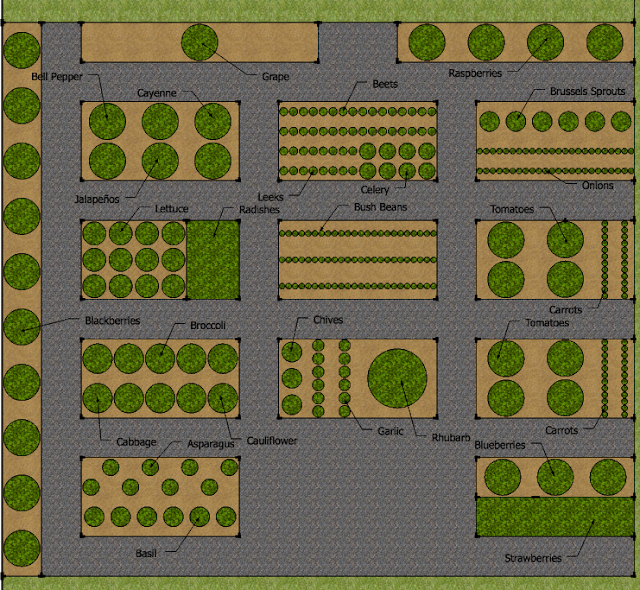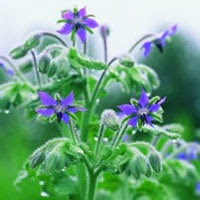The seeds we planted last week have yet to sprout. The germination time range from 7 to 21 days, so we don't really expect any action for another week or so. However, I had planned on posting weekly pictures of the growing seedlings, so the first week's picture is to the left.
The weather has been fantastic! For the past few days, highs have been in the mid-60s, and they expect mid-70s in the coming week! Because of the great weather (and the late sunsets), we have been spending time cleaning up the garden and getting ready for the coming summer. We pruned the blackberries and raspberries to 30 inches high, cutting just above last year's buds. We also trimmed back the perennial plants (strawberries, chives, and asparagus), pulled some weeds, raked leaves, and generally cleaned up the area.
Last year, a friend from church gave us some rhubarb root, which we planted by the asparagus. Rhubarb propagates via a
rhizome, like ginger and many flowers (think Day Lilies) and grasses. To transplant it, you simply cut off a piece of the root and re-plant it. We didn't realize how fast the rhubarb would grow (we don't grow rhubarb in Texas), so we placed it in a poor spot. I needs about four feet of room for a single rhubarb plant, so we moved it to a bed with more space. The rhubarb rhizome is shown to the right, and is about a foot in diameter and eight inches high. When we planted it last year, it was about a fourth of that size!

We have finally completed our plan for the garden layout this year. We added some new plants and extended the garden a bit. A drawing of the layout of the garden area is shown to the left. The wheat field is located in the upper-right corner of the garden, and there was originally a plan for a second field to the left of that. Instead, we decided to plant vegetables there, and possibly extend the wheat further upward in the future. In the center of the drawing is the main garden area, which I will show in more detail below.
Last year we also planted two dwarf peach trees, one above the blackberries and one below. The one that was planted above the blackberries died, so the only existing fruit tree is the one below the blackberries (at the center-left of the drawing). This year, we are going to plant a second peach tree to the right of the drawing nearer the house, as well as two dwarf apricot trees, as shown at the bottom of the drawing. All of these trees will grow to only between 12 and 15 feet in height, but will produce full-sized fruit in a few years. We buy our trees bare-root from
Miller Nurseries. They are located in the Finger Lakes region, and have lots of tree varieties that are well-suited to our climate.
First I'll talk about the plants we are growing next to the wheat, then I will go over the main garden. The main garden is built of raised beds, about six inches in height, but the back portion of the garden is at ground level. A drawing of that part of the garden is show below. The wheat field is on the right. It is a 16-foot square, and is planted with hard red winter wheat, which we will use for making bread. We planted the wheat in the fall, and it is about three inches high now.
Along the fence at the far-left of the drawing we will have two rows of corn, followed by two rows of potatoes. These rows are all two feet wide. Then, we have two four-foot rows of vine plants, including pickling cucumbers, summer and winter squash, cantaloupe, pumpkin, and watermelon. These vine plants all need rows four feet in width, and the watermelon needs between six and eight feet of row for one plant!
Below is the drawing of the main garden for this year. The garden is 28 feet long (height on the screen) and 32 feet wide. The blackberries are to the left of the drawing, the grape vine is at the top-left, and the raspberries are at the top-right. There are other perennials scattered through the garden, but most are annuals that we can (and should!) change from year to year. There are many resources for guidelines on rotating vegetables, and some can be seen in the Amazon gadget on the right side of the blog.


I will start in the top-left bed and move to the right and down the drawing. First, we have our pepper plants. Last year, we planted four bell peppers and two jalapenos, but we decided to only do two bell peppers this year. A friend from work also gave us two heirloom seedlings from a pepper plant her father planted years ago. We originally thought they were Anaheim peppers, but once they grew we assumed they were cayenne. We have since learned that they are in fact Chile de árbol peppers, which are about as hot as cayenne, and are usually dried and ground and used as a seasoning, just as cayenne peppers are. We will plant two of those plants in that bed as well.

The next bed will be for beets, leeks, and celery, which are all new for us. Celery is infamously the most difficult garden vegetable to grow. Most gardeners recommend just buying it from the grocery store instead of trying to grow it yourself, but they also recommend trying to grow it for fun, so we will try. The final bed on the top row will be for Brussels sprouts, which are new for us as well, and onions, which are not new.
On the next row, we will plant lettuce and radishes in the first bed. Lettuce grows rather quickly, but doesn't store well, so we will start these seeds about two weeks before last frost, and plant new seeds every week afterward. That way, we will have a couple heads of fresh lettuce throughout the summer. Next we have bush beans, which are susceptible to frost and can't be planted until a couple weeks into June! Finally, tomatoes and carrots. This year we will plant two cherry tomatoes, two beefsteaks, and four heirlooms. We hope to have enough to can (if we don't eat them all fresh!), and we plan on interspersing the plants with borage, a flower/herb that repels hornworms.
 |
| Tomato hornworm |
The next row will have cabbage, broccoli, and cauliflower (all new) in the first bed. The middle bed is perennial, and includes chives and garlic, as well as the large rhubarb plant. Garlic is traditionally planted in the fall, but can also be planted in the spring, which is when we will plant ours. The bottom row is also mostly perennial, but we will plant basil in the asparagus bed (we usually pant basil with tomatoes, but it pairs well with asparagus as well). The last bed contains strawberries and blueberries.
That's all for this week. Next week we hope to have cilantro, celery, and leek seedlings, and we will plant lots of new seeds, including peppers, tomatoes, some herbs, and more! I will also talk about companion flowers!
 While we are waiting for the seedlings to graduate to peat pots and lights (and grow very large), I want to spend a few weeks talking about several general gardening topics. The first topic I want to cover is companion planting, specifically companion flowers. We have spent a lot of time researching companion planting. The reason for this is that most pests can be dealt with without using pesticides, by simply intelligently planning your garden and adding certain plants to target certain species of pests. Other plants can be used to attract pollinators (like bees) and predators (like ladybugs).
While we are waiting for the seedlings to graduate to peat pots and lights (and grow very large), I want to spend a few weeks talking about several general gardening topics. The first topic I want to cover is companion planting, specifically companion flowers. We have spent a lot of time researching companion planting. The reason for this is that most pests can be dealt with without using pesticides, by simply intelligently planning your garden and adding certain plants to target certain species of pests. Other plants can be used to attract pollinators (like bees) and predators (like ladybugs).



















